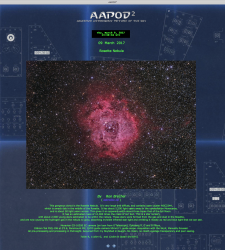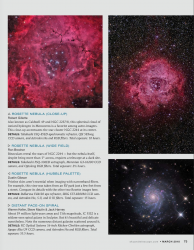The Rosette Nebula
 Click image for full size version
Click image for full size version
December 7, 2016, Amateur Astronomy Picture of the Day, March 9, 2017, Sky & Telescope, March 2018

 This gorgeous donut is the Rosette Nebula. It’s very large and diffuse, and contains open cluster NGC2244, which is smack dab in the middle of the Rosette. It lies about 5,200 light years away in the constellation Monoceros, and is about 50 light years across. This gives it an apparent width about three times that of the full Moon. It has an estimated mass of 10,000 times the mass of our Sun. This is a star nursery, with about 2,500 young stars estimated to be within the nebula. These stars were formed from the gas and dust in the Rosette, and are now causing the hydrogen gas in the nebula to glow, absorbing invisible infrared star light and emitting it mostly as red and blue light that we can see.
This gorgeous donut is the Rosette Nebula. It’s very large and diffuse, and contains open cluster NGC2244, which is smack dab in the middle of the Rosette. It lies about 5,200 light years away in the constellation Monoceros, and is about 50 light years across. This gives it an apparent width about three times that of the full Moon. It has an estimated mass of 10,000 times the mass of our Sun. This is a star nursery, with about 2,500 young stars estimated to be within the nebula. These stars were formed from the gas and dust in the Rosette, and are now causing the hydrogen gas in the nebula to glow, absorbing invisible infrared star light and emitting it mostly as red and blue light that we can see.
The last time I shot this object was in January 2012 – it was one of the first light images with a then-new camera and different scope. Interesting comparison!
Tekkies:
Moravian G3-16200 EC camera (on loan from O’Telescope), Optolong R, G and B filters, 106mm Tak FSQ-106 at f/3.6, Paramount MX, QHY5 guide camera 50mm f.l. guide scope. Acquisition with the SkyX, Manually focused. All pre-processing and processing in PixInsight. Acquired from my SkyShed in Guelph. No moon, no cloud, average transparency and poor seeing.
7x5m R, 11x5m G, and 12x5m B (total=2hr30m).
RGB Creation
Creation and cleanup: ImageIntegration was used to make R, G and B masters, which were cropped and processed separately with DBE. R, G and B were combined to make an RGB image which was processed with BackgroundNeutralization. ColorCalibration was then applied.
Linear Noise Reduction: MultiscaleLinearTransform was used to reduce noise in the background areas of the RGB file. Layer settings for threshold and strength: Layer 1: 3.0, 0.6 Layer 2: 2.0, 0.45 Layer 3: 1.5, 0.33 Layer 4: 1.0, 0.2 and Layer 5: 0.5, 0.13
Stretching: HistogramTransformation was applied using autostretch settings from ScreenTransferFunction.
Synthetic Luminance:
Creation and cleanup of SynthL: The cleaned up R, G and B masters were combined using the ImageIntegration tool (average, additive with scaling, noise evaluation, iterative K-sigma / biweight midvariance, no pixel rejection).
Deconvolution: A star mask was made to use as a local deringing support. A copy of the image was stretched to use as a range mask. Deconvolution was applied (80 iterations, regularized Richardson-Lucy, external PSF made using DynamicPSF tool with about 25 stars).
Linear Noise Reduction: MultiscaleLinearTransform was used to reduce noise in the background areas of the NB-RGB file. Layer settings for threshold and strength: Layer 1: 3.0, 0.6 Layer 2: 2.0, 0.45 Layer 3: 1.5, 0.33 Layer 4: 1.0, 0.2 and Layer 5: 0.5, 0.13.
Stretching: HistogramTransformation was applied using autostretch settings from ScreenTransferFunction.
Noise Reduction and Re-Stretch: TGVDenoise was applied in Lab mode with 300 iterations with a range mask used to protect high signal areas. This was followed by a HistogramTransformation to raise the black point (but with no clipping).
Contrast Enhancement: The contrast decrease caused by HDRMultiscaleTransform was restored with LocalHistogramEqualization (scale 124, strength 0.33, max contrast 1.5).
Combining SynthL with RGB:
The processed SynthL was applied to the RGB image using LRGBCombine with default settings.
Additional Processing
Final Steps: LocalHistogramEqualization was applied twice (scale 50, strength 0.33, max contrast 1.5 and scale 124, strength 0.35, max contrast 1.5) using a mask to protect stars and background. This was followed by MultiscaleLinearTransform (layers 2-4 at 0.05) with the same mask to sharpen the structures in the nebula. Background, nebula and star brightness, contrast and saturation were adjusted in several iterations using Curves with masks as required. MorphologicalTransformation was applied to the large and medium sized stars to shrink them slightly.
Image scale is about 3.2 arcsec per pixel for this camera / telescope combination.






Another great shot! There is a strong 3 dimensional effect with the hole at the center.
I just by chance found your page..Your images are out of this world..I really like the fact that you explain the processes used in PI…Being new to using PI I need all the intel I can gather.Thanks for sharing.
Amazing work…
Thanks!